
Eyrecourt, historically known as Donanaghta, is a village in County Galway, Ireland. Eyrecourt is on the R356 regional road 12 km west of the Banagher bridge over the River Shannon.

Portumna is a market town in the south-east of County Galway, Ireland, on the border with and linked by a bridge to County Tipperary. The town is located to the west of the point where the River Shannon enters Lough Derg. This historic crossing point over the River Shannon between counties Tipperary and Galway has a long history of bridges and ferry crossings. On the south-western edge of the town lie Portumna Castle and Portumna forest park.
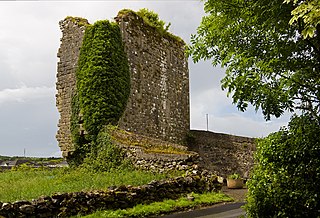
Castlegar is a village and electoral division in County Galway, just outside the city of Galway, in Ireland. Castlegar is also an ecclesiastical parish in the Roman Catholic Diocese of Galway, Kilmacduagh and Kilfenora. It extends from Lough Corrib across to Merlin Park by the old Galway-Dublin road.

Ballymore Castle in Lawrencetown, County Galway, Ireland was originally a 15th-century tower house belonging to O'Madden. A house was added in 1620, and the castle has been much altered since then.

Joseph Canning is an Irish hurler who plays for club side Portumna and previously at inter-county level with the Galway senior hurling team. Often considered one of the greatest players of his generation and widely regarded as one of the greatest hurlers of all time, Canning enjoyed a 14-season career with the Galway senior hurling team, won five All-Stars and was named GAA-GPA Hurler of the Year in 2017. He won seven major trophies in his inter-county career, including one All-Ireland Championship, three Leinster Championships and three National Hurling Leagues. A prolific scorer from play and placed balls, Canning holds the record for most sideline cuts scored (28) and is the championship's all-time top scorer with 27 goals and 486 points. His 62 championship appearances is a Galway record.

Thoor Ballylee Castle is a fortified, 15th-century Anglo-Norman tower house built by the septs de Burgo, or Burke, near the town of Gort in County Galway, Ireland. It is also known as Yeats's Tower because it was once owned and inhabited by the poet William Butler Yeats.

In Ireland at the end of the sixteenth and beginning of the seventeenth century, the fortified house, along with the stronghouse, developed as a replacement for the tower house. 'Fortified Houses' were often rectangular, or sometimes U or L-shaped, three-storey structures with high gables and chimney stacks and large windows with hood mouldings. Some examples have square towers at the corners. The interiors were relatively spacious with wooden partitions and numerous fireplaces. In a number of cases 'Fortified Houses' were built onto pre-existing tower houses. 'Fortified Houses' were protected by gun fire from the angle towers and bartizans, and were also provided with bawn walls with gunloops, towers and protected gateways. 'Fortified Houses' were built throughout Ireland by large landowners from a variety of backgrounds, such as the Old English Earl of Clanricarde who built Portumna Castle in County Galway; Gaelic lords such as MacDonogh MacCarthy, Lord of Duhallow, who built Kanturk Castle in County Cork; and Cromwellian soldiers such as Sir Charles Coote, who built Rush Hall in County Offaly.
Over the past six decades studies concerning Irish 'Fortified Houses' have identified them as a transitional genre that emerged at the end of the sixteenth century and acted as an architectural bridge between the Irish medieval tower-house and the country manor house of the late seventeenth century. The 'Fortified House' drew on the earlier tradition of the tower-house and was influenced by the Tudor and emerging Jacobean architecture from England and the Classical and Military architecture coming from Continental Europe. The social, political and military changes that took place from the 1580s-1650s were to play a major role in the development of this unique Irish structure. These houses provided a comfortable living space for the elite of early seventeenth-century Irish society. They were fashionable yet defendable. The 'Fortified House' was a public display of power and wealth. They represented a long term investment in their owner’s regional future and were monuments to an aspiration for an English and Continental house style suited to local Irish conditions. On a basic level the construction of a 'Fortified House' represented the owners’ desire to modernise and Anglicize.

Portumna Castle is a semi-fortified house in Portumna, County Galway, Ireland which was built in the early 17th century by Richard Burke, 4th Earl of Clanricarde.

Dunsoghly Castle is a castle and a National Monument located in the civil parish of St. Margarets, in Fingal, Ireland. The castle has been in state ownership since 1914. It is managed by the Office of Public Works.
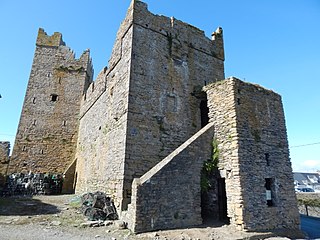
Slade Castle is a tower house and National Monument in County Wexford, Ireland. It is located in the village of Slade on the Hook Peninsula and primarily dates to the late 15th or early 16th century.

Athenry Castle is a tower house and National Monument located in Athenry, Ireland.
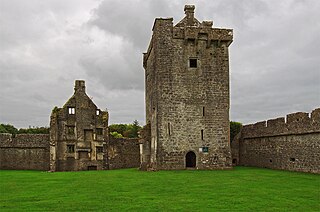
Pallas Castle is a tower house and National Monument located in County Galway, Ireland.
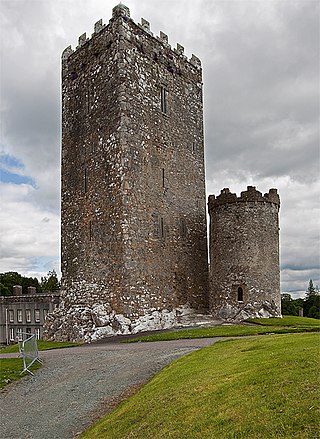
Drishane Castle is a MacCarthy tower house and National Monument located in County Cork, Ireland. In modern times the name is also used to refer to the adjacent house which dates from the 18th century. It is located 2.2 km (1.4 mi) northeast of Millstreet, on the south bank of the Munster Blackwater.

Fanning's Castle, also called Whitamore's Castle, is the remains of a tower house and National Monument located in Limerick, Ireland.

Killursa is a medieval church and national monument in County Galway, Ireland. The church is located on the outskirts of Westport, about east-northeast of the town of Galway. It has a rectangular mass in the Early Christian or Romanesque style, with an octagonal tower at its northeast corner. The tower was apparently added in the 15th century. The church is datable from the 12th century, and may have been founded by St. Columba. The current structure is from the 16th century.

Ardamullivan Castle is a tower house and National Monument located in County Galway, Ireland.
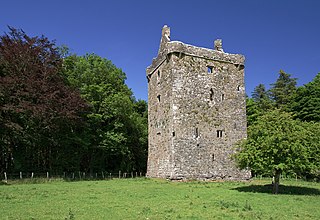
Feartagar Castle, also called Jennings Castle, is a tower house and National Monument located in County Galway, Ireland.

Roscam is a medieval ecclesiastical site and National Monument located in County Galway, Ireland.

Portumna Abbey is a medieval Cistercian friary and National Monument located in Portumna, Ireland.

Kiltartan Castle is a tower house and National Monument located in County Galway, Ireland.





















